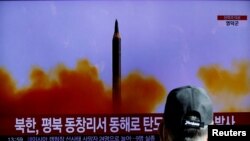North Korea capped off its record year of missile tests by sending three more ballistic missiles into the sea off its east coast Saturday, according to South Korea’s military.
The North fired three short-range ballistic missiles from North Hwanghae Province starting about 8 a.m. local time, South Korea’s Joint Chiefs of Staff said in a statement.
Japan’s Coast Guard earlier reported that two North Korean missiles were launched. The reason for the discrepancy was not immediately clear.
It is North Korea’s 37th launch event this year — its most ever, by far. Many of those launches have involved multiple missiles.
No other details were immediately available about the latest launch, which comes just ahead of expected end-of-year comments by North Korean leader Kim Jong Un.
During a year-end address two years ago, Kim laid out an ambitious weapons wish list. Since then, his country has made rapid progress developing many of the items on that list.
As a result of its testing flurry, North Korea can likely field missiles that fly faster and for longer distances, launch more quickly, and better evade the missile defenses of its foes, analysts say.
North Korea has also used low-tech systems to harass its neighbors. Earlier this week, North Korea sent at least five small drones into South Korea, presumably as part of a reconnaissance mission, according to South Korean officials.
Not only did South Korea fail to shoot down any of the suspected North Korean drones, it eventually lost track of all but one of them. South Korea’s military says one of the drones flew as far as northern Seoul before returning to the North. It is not clear what happened to the other four.
North Korea has sent tiny, crudely built drones into South Korea on several occasions, including in 2014 and 2017. In at least some of those incidents, the unmanned aerial vehicles took pictures of South Korean government facilities and attempted to return to the North before crashing near the border.
The latest incursion prompted an apology from South Korea’s military, which vowed to boost its air defenses so that it can better track small objects that cross the border. Seoul officials have said the current systems cannot easily identify objects smaller than 3 meters.
North Korea has not commented on the drone incident.
In recent months, North Korea has taken an increasingly hostile attitude toward the United States and its allies South Korea and Japan.
Some of the North Korean missiles have flown over Japan and come very close to South Korea’s coast, prompting take-shelter warnings in parts of both countries.
In response, the United States and its allies have increased diplomatic and defense coordination and ramped up their own displays of military strength.
With each side blaming the other for raising tensions, it is not clear when the current cycle of provocations will end.
In the past, North Korea has intentionally created a sense of crisis, seemingly in order to gain leverage ahead of negotiations with the United States.
However, North Korea this year has repeatedly stated it is not interested in talks and that it will never trade away its nuclear weapons.
Under President Joe Biden, the United States has said it is open to talks with North Korea but that the discussions must focus on denuclearization.







